Growth of Pentacene-Doped p-Terphenyl Crystals Using SSVBT and Doping Effects in p-Terphenyl Molecular Crystals
Abstract
1. Introduction
2. Materials and Methods
2.1. Design of Growth Container
2.2. Growth of Pure and Pentacene-Doped p-Terphenyl Crystals
2.3. Characterization Techniques
3. Results and Discussion
3.1. Morphology Analyses of Pentacene-Doped p-Terphenyl Crystals
3.2. Powder X-ray Diffraction Analyses
3.3. Fluorescence Spectrum Analyses
3.4. Ultraviolet–Visible Absorption Spectrum Analyses
3.5. FTIR and Transmission Spectral Analyses
3.6. 1H NMR Spectrum Analyses
4. Conclusions
Author Contributions
Funding
Data Availability Statement
Acknowledgments
Conflicts of Interest
References
- He, Z.; Chen, J.; Li, D. Crystal alignment for high performance organic electronics devices. J. Vac. Sci. Technol. A 2019, 37, 040801. [Google Scholar] [CrossRef]
- Sun, L.; Wang, Y.; Yang, F.; Zhang, X.; Hu, W. Cocrystal engineering: A collaborative strategy toward functional materials. Adv. Mater. 2019, 31, 1902328. [Google Scholar] [CrossRef] [PubMed]
- Wang, J.; Zhang, S.; Xu, S.; Li, A.; Li, B.; Ye, L.; Geng, Y.; Tian, Y.; Xu, W. Morphology-dependent luminescence and optical waveguide property in large-size organic charge transfer cocrystals with anisotropic spatial distribution of transition dipole moment. Adv. Opt. Mater. 2019, 8, 1901280. [Google Scholar] [CrossRef]
- Mercier, G.M.; Robeyns, K.; Tumanov, N.; Champagne, B.; Wouters, J.; Leyssens, T. New insights into photochromic properties of n-salicylideneaniline derivatives using a cocrystal engineering approach. Cryst. Growth Des. 2019, 19, 5544–5556. [Google Scholar] [CrossRef]
- Jalili, B.; Ghafoori, H.; Jalili, P. Investigation of carbon nano-tube (CNT) particles effect on the performance of a refrigeration cycle. Int. J. Mater. Sci. Innov. 2014, 2, 8–17. [Google Scholar]
- Fan, C.; Lin, W.; Chang, H.; Lin, Y.; Huang, B. Effects of the F4TCNQ-doped pentacene interlayers on performance improvement of top-contact pentacene-based organic thin-film transistors. Materials 2016, 9, 46. [Google Scholar] [CrossRef]
- Maeda, Y.; Ohmi, S. Steep subthreshold swing of pentacene-based organic field-effect transistor with nitrogen-doped LaB6 interfacial layer. Jpn. J. Appl. Phys. 2017, 56, 04CL06. [Google Scholar] [CrossRef]
- Lee, H.; Huang, H. Investigation performance and mechanisms of inverted polymer solar cells by pentacene doped P3HT: PCBM. Int. J. Photoenergy 2014, 2014, 812643. [Google Scholar] [CrossRef]
- Raghuwanshi, V.; Bharti, D.; Tiwari, S.P. Flexible organic field-effect transistors with TIPS-Pentacene crystals exhibiting high electrical stability upon bending. Org. Electron. 2016, 31, 177–182. [Google Scholar] [CrossRef]
- Gatti, T.; Brambilla, L.; Tommasini, M.; Villafiorita-Monteleone, F.; Botta, C.; Sarritzu, V.; Mura, A.; Bongiovanni, G.; Zoppo, M.D. Near IR to red up-conversion in tetracene/pentacene host/guest cocrystals enhanced byenergy transfer from host to guest. J. Phys. Chem. C 2015, 119, 17495–17501. [Google Scholar] [CrossRef]
- Ma, Y.; Zhou, Y.; Jin, J.; Wang, W.; Liu, X.; Xu, H.; Zhang, J.; Huang, W. Pentacene derivative/DTTCNQ cocrystals: Alkyl-confined mixed heterojunctions with molecular alignment and transport property tuning. Chem. Sci. 2019, 10, 11125–11129. [Google Scholar] [CrossRef] [PubMed]
- Fang, X.; Yang, X.; Yan, D. Vapor-phase π-π molecular recognition: A fast and solvent-free strategy towards the formation of co-crystalline hollow microtube with 1D optical waveguide and up-conversion emission. J. Mater. Chem. C 2017, 5, 1632–1637. [Google Scholar] [CrossRef]
- Cui, S.; Liu, Y.; Li, G.; Han, Q.; Ge, C.; Zhang, L.; Guo, Q.; Ye, X.; Tao, X. Growth regulation of pentacene-doped p-terphenyl crystals on their physical properties for promising maser gain medium. Cryst. Growth Des. 2020, 20, 783–792. [Google Scholar] [CrossRef]
- Oxborrow, M.; Breeze, J.D.; Alford, N.M. Room-temperature solid-state maser. Nature 2012, 488, 353–356. [Google Scholar] [CrossRef]
- Breeze, J.; Tan, K.J.; Richards, B.; Sathian, J.; Oxborrow, M.; Alford, N.M. Enhanced magnetic Purcell effect in room-temperature masers. Nat. Commun. 2015, 6, 6215. [Google Scholar] [CrossRef]
- Bogatko, S.; Haynes, P.D.; Sathian, J.; Wade, J.; Kim, J.S.; Tan, K.J.; Breeze, J.; Salvadori, E.; Horsfield, A.; Oxborrow, M. Molecular design of a room-temperature maser. J. Phys. Chem. C 2016, 120, 8251–8260. [Google Scholar] [CrossRef]
- Salvadori, E.; Breeze, J.D.; Tan, K.J.; Sathian, J.; Richards, B.; Fung, M.W.; Wolfowicz, G.; Oxborrow, M.; Alford, N.M.; Kay, C.W.M. Nanosecond time-resolved characterization of a pentacene based room-temperature MASER. Sci. Rep. 2017, 7, 41836. [Google Scholar] [CrossRef]
- Ai, Q.; Chen, P.; Feng, Y.; Xu, Y. Growth of pentacene-doped p terphenyl crystals by vertical Bridgman technique and doping effect on their characterization. Cryst. Growth Des. 2017, 17, 2473–2477. [Google Scholar] [CrossRef]
- Ai, Q.; Chen, P.; Feng, Y.; Xu, Y. Effect of growth-vessel design on the properties of p-terphenyl single crystals grown by vertical Bridgman technique. In Proceedings of the 3rd International Conference on Chemical Materials and Process, Beijing, China, 25–27 May 2017. [Google Scholar]
- Ai, Q.; Chen, P.; Feng, Y.; Xu, Y. Enhanced crystalline perfection and fluorescence properties of p-terphenyl single crystals grown by the vertical Bridgman technique with a novel modified growth vessel. J. Appl. Crystallogr. 2017, 50, 278–282. [Google Scholar] [CrossRef]
- Kuwabara, T.; Nakajima, H.; Nanasawa, M.; Ueno, A. Color change indicators for molecules using methyl red-modified cyclodextrins. Anal. Chem. 1999, 71, 2844–2849. [Google Scholar] [CrossRef]
- Mitsui, M.; Kawano, Y. Electronic energy transfer in tetracene-doped p-terphenyl nanoparticles: Extraordinarily high fluorescence enhancement and quenching efficiency. Chem. Phys. 2013, 419, 30–36. [Google Scholar] [CrossRef]
- Rice, A.P.; Tham, F.S.; Chronister, E.L. A Temperature Dependent X-ray Study of the Order–Disorder Enantiotropic Phase Transition of p-Terphenyl. J. Chem. Crystallogr. 2013, 43, 14–25. [Google Scholar] [CrossRef]
- Siegrist, T.; Besnard, C.; Haas, S.; Schiltz, M.; Pattison, P.; Chernyshov, D.; Batlogg, B.; Kloc, C. A Polymorph Lost and Found: The High-Temperature Crystal Structure of Pentacene. Adv. Mater. 2007, 19, 2079–2082. [Google Scholar] [CrossRef]
- Costa, A.M.A.D.; Amado, A.M. Doping effects in p-terphenyl molecular crystals: A study by Raman spectroscopy. Solid State Ionics 1999, 125, 263–269. [Google Scholar] [CrossRef]
- Selvakumar, S.; Sivaji, K.; Arulchakkaravarthi, A.; Sankar, S. Enhanced fluorescence and time resolved fluorescence properties of p-terphenyl crystal grown by selective self seeded vertical Bridgman technique. Mater. Lett. 2007, 61, 4718–4721. [Google Scholar] [CrossRef]
- Antoine, R.; Dugourd, P. UV–Visible Activation of Biomolecular Ions. In Laser Photodissociation and Spectroscopy of Mass-Separated Biomolecular Ions; Polfer, N.C., Dugourd, P., Eds.; Springer International Publishing: Cham, Switzerland, 2013; pp. 93–116. [Google Scholar]
- Wilson, M.W.B.; Rao, A.; Ehrler, B.; Friend, R.H. Singlet exciton fission in polycrystalline pentacene: From photophysics toward devices. Acc. Chem. Res. 2013, 46, 1330–1338. [Google Scholar] [CrossRef]
- Murai, Y.; Misaki, M.; Ishida, K.; Ueda, Y. Pillarlike crystals of pentacene prepared from soluble precursor. Appl. Phys. Express 2011, 4, 121603. [Google Scholar] [CrossRef]
- Iwata, K.; Hamaguchi, H. Picosecond time-resolved Raman spectroscopy of S1 p-terphenyl and p-terphenyl-d14 in solution: Time-dependent changes of Raman band shapes. J. Raman Spectrosc. 1994, 25, 615–621. [Google Scholar] [CrossRef]
- Ross, D.; Aroca, R. Effective medium theories in surface enhanced infrared spectroscopy: The pentacene example. J. Chem. Phys. 2002, 117, 8095–8103. [Google Scholar] [CrossRef]
- Hosoi, Y.; Okamura, K.; Kimura, Y.; Ishii, H.; Niwano, M. Infrared spectroscopy of pentacene thin film on SiO2 surface. Appl. Surf. Sci. 2005, 244, 607–610. [Google Scholar] [CrossRef]
- Nagano, M.; Hasegawa, T.; Myoujin, N.; Yamaguchi, J.; Itaka, K.; Fukumoto, H.; Yamamoto, T.; Koinuma, H. The first observation of 1H-NMR spectrum of pentacene. Jpn. J. Appl. Phys. 2004, 43, L315–L316. [Google Scholar] [CrossRef]
- Kupka, T.; Stachow, M.; Nieradka, M.; Stobinski, L. DFT calculation of structures and NMR chemical shifts of simple models of small diameter zigzag single wall carbon nanotubes (SWCNTs). Magn. Reson. Chem. 2011, 49, 549–557. [Google Scholar] [CrossRef] [PubMed]
- Selvakumar, S.; Sivaji, K.; Balamurugan, N.; Arulchakkaravarthi, A.; Sankar, S.; Venkateswaran, C.; Ramasamy, P. Growth and studies on SSVBT grown p-terphenyl single crystals. J. Cryst. Growth 2005, 275, e265–e271. [Google Scholar] [CrossRef]
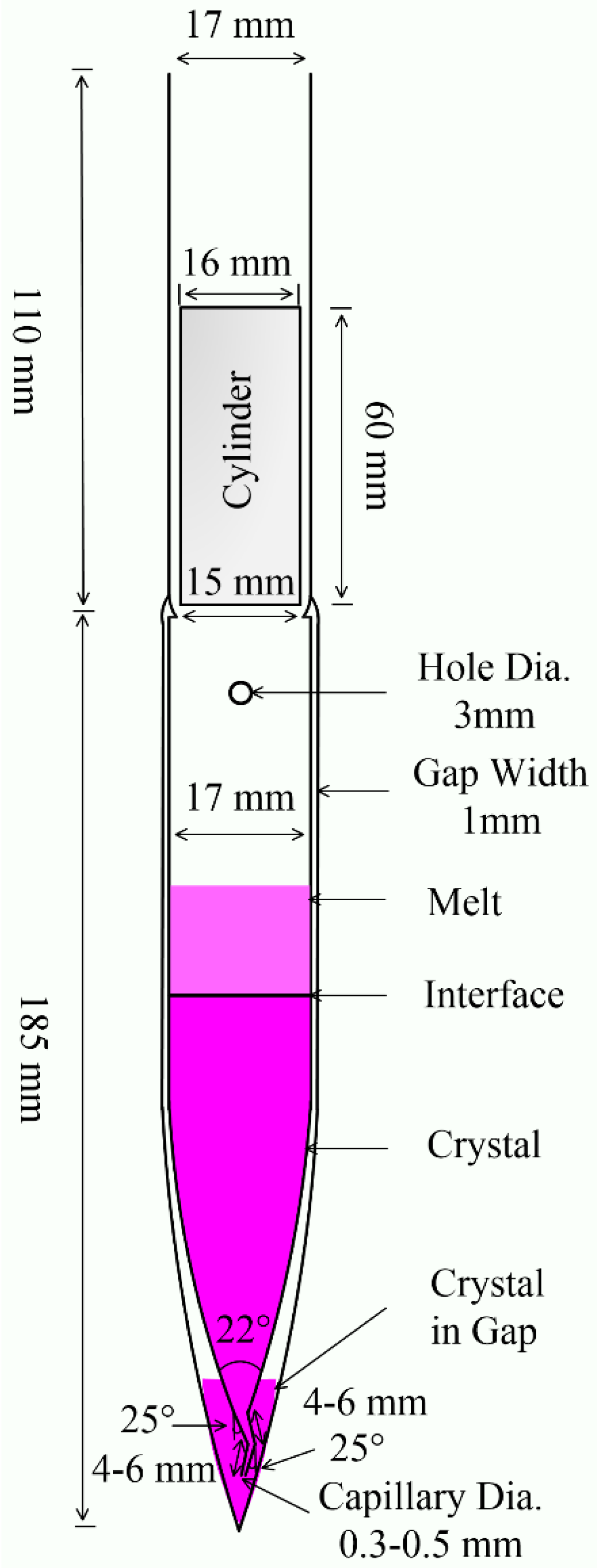

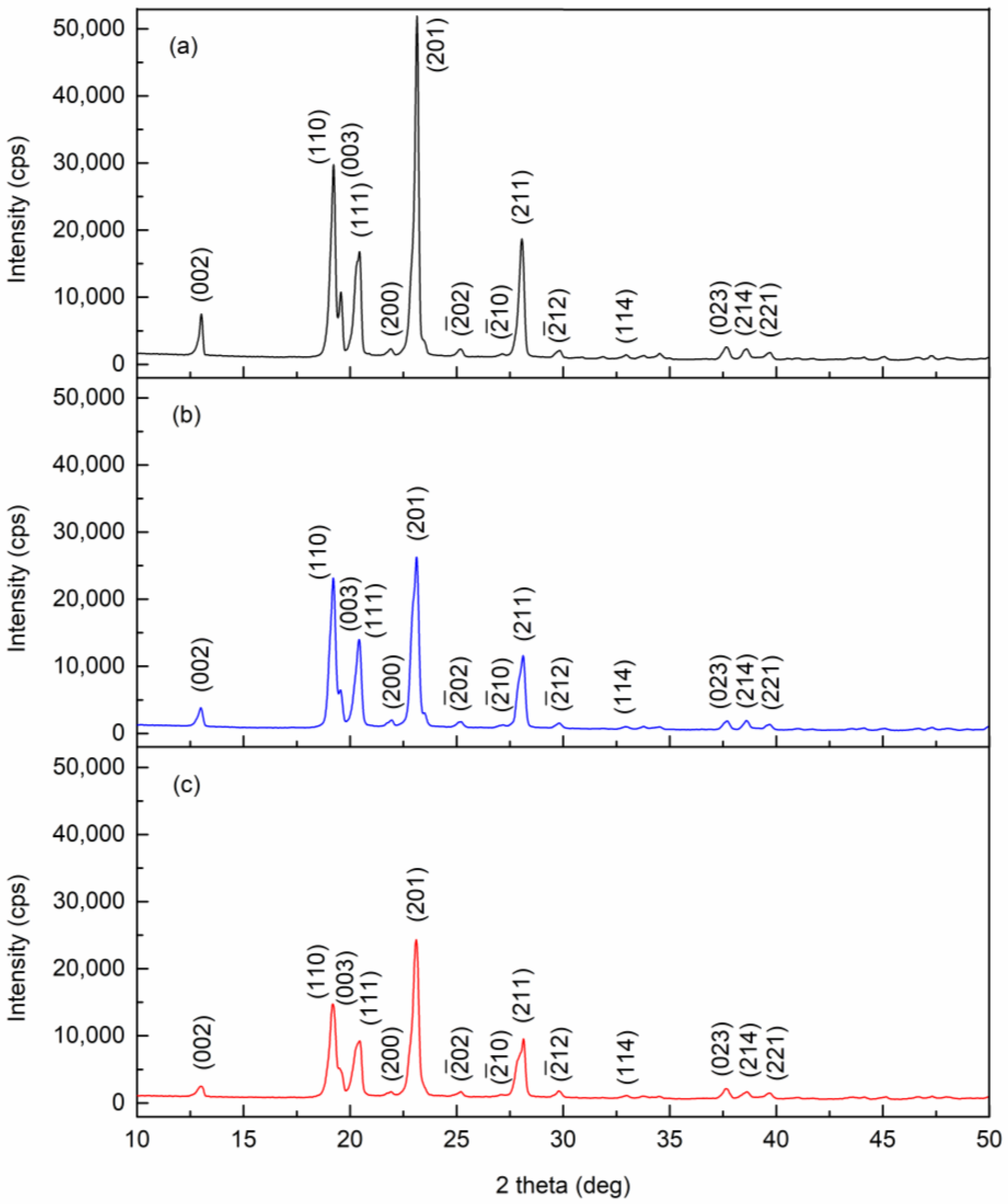
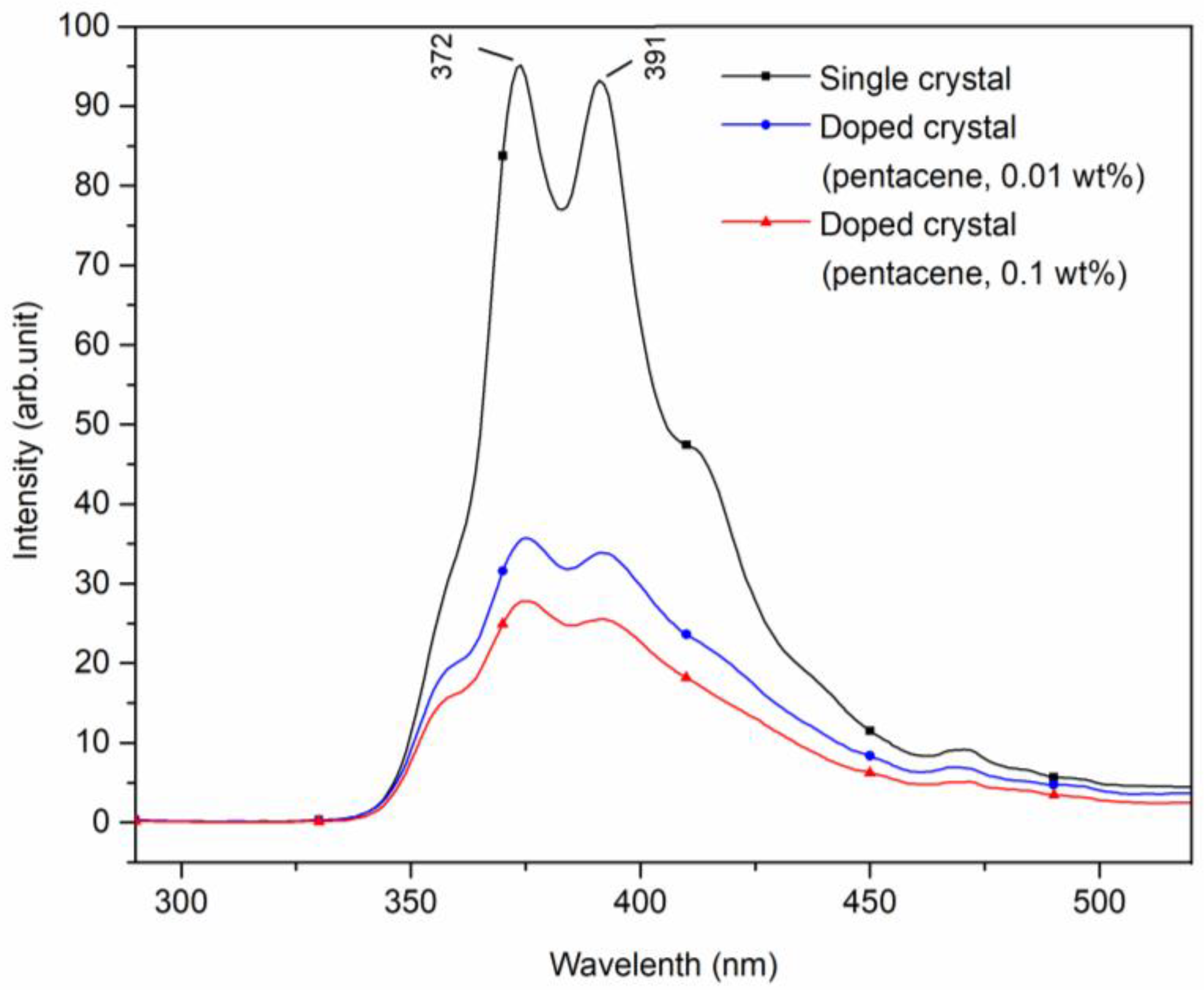
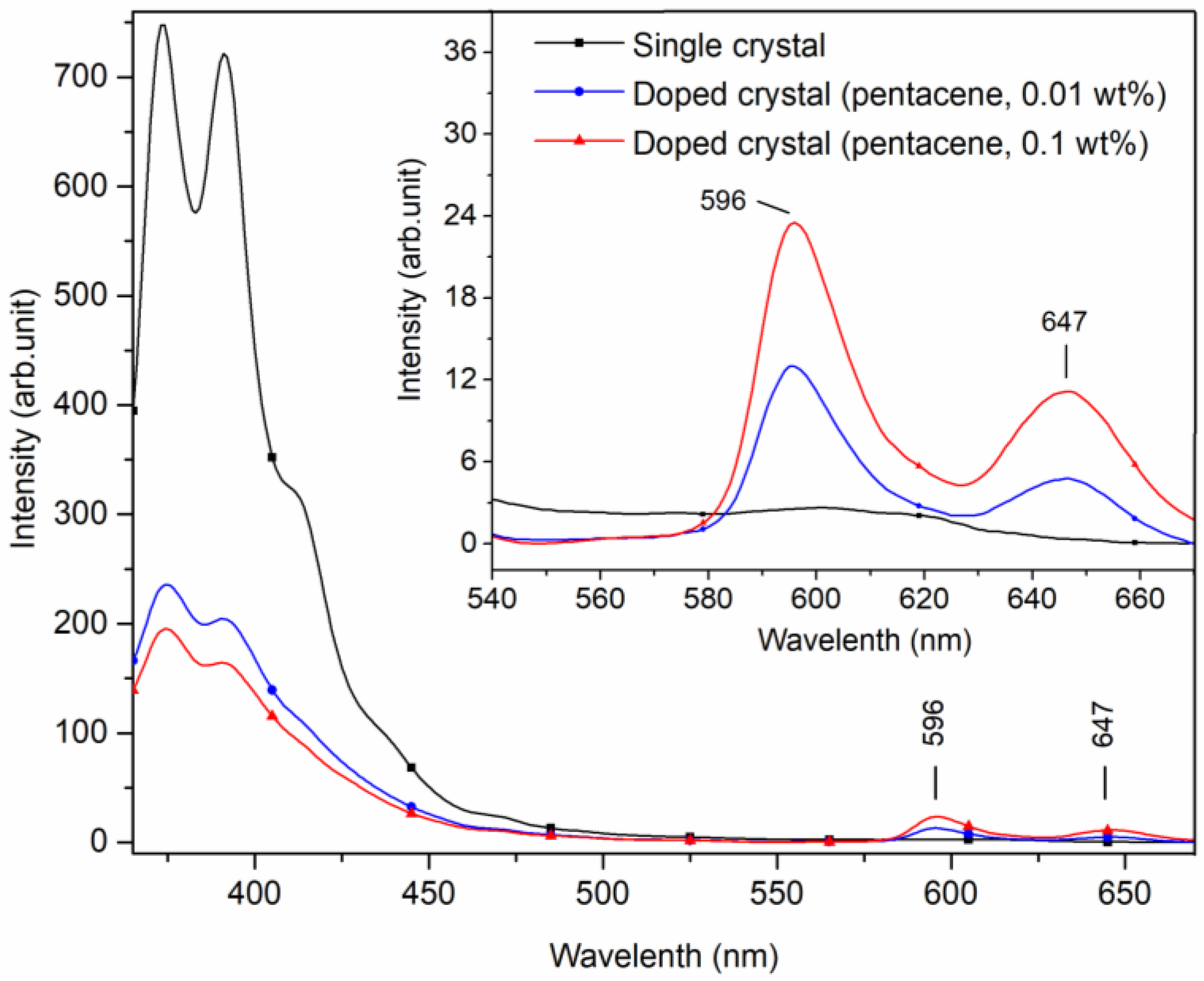

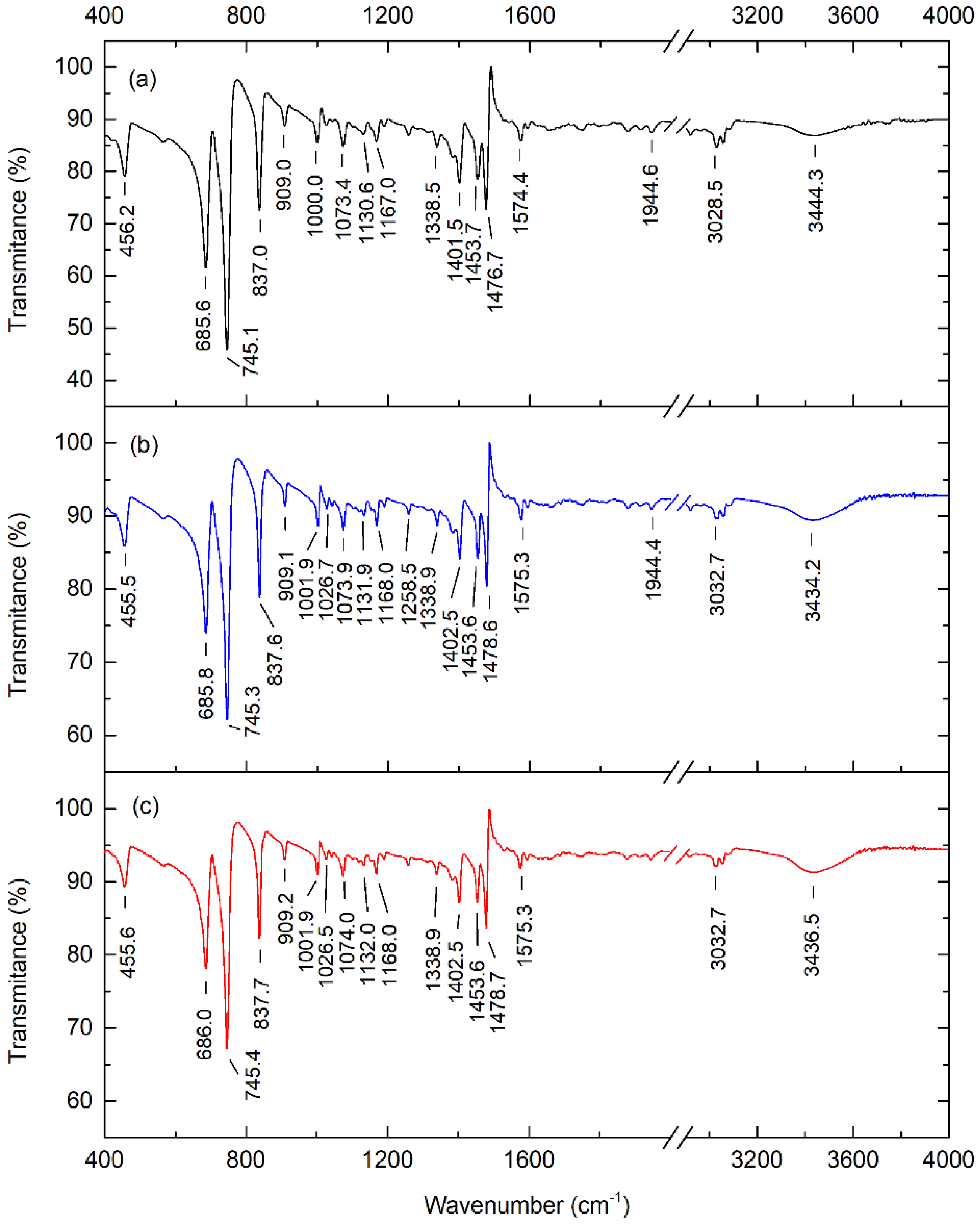
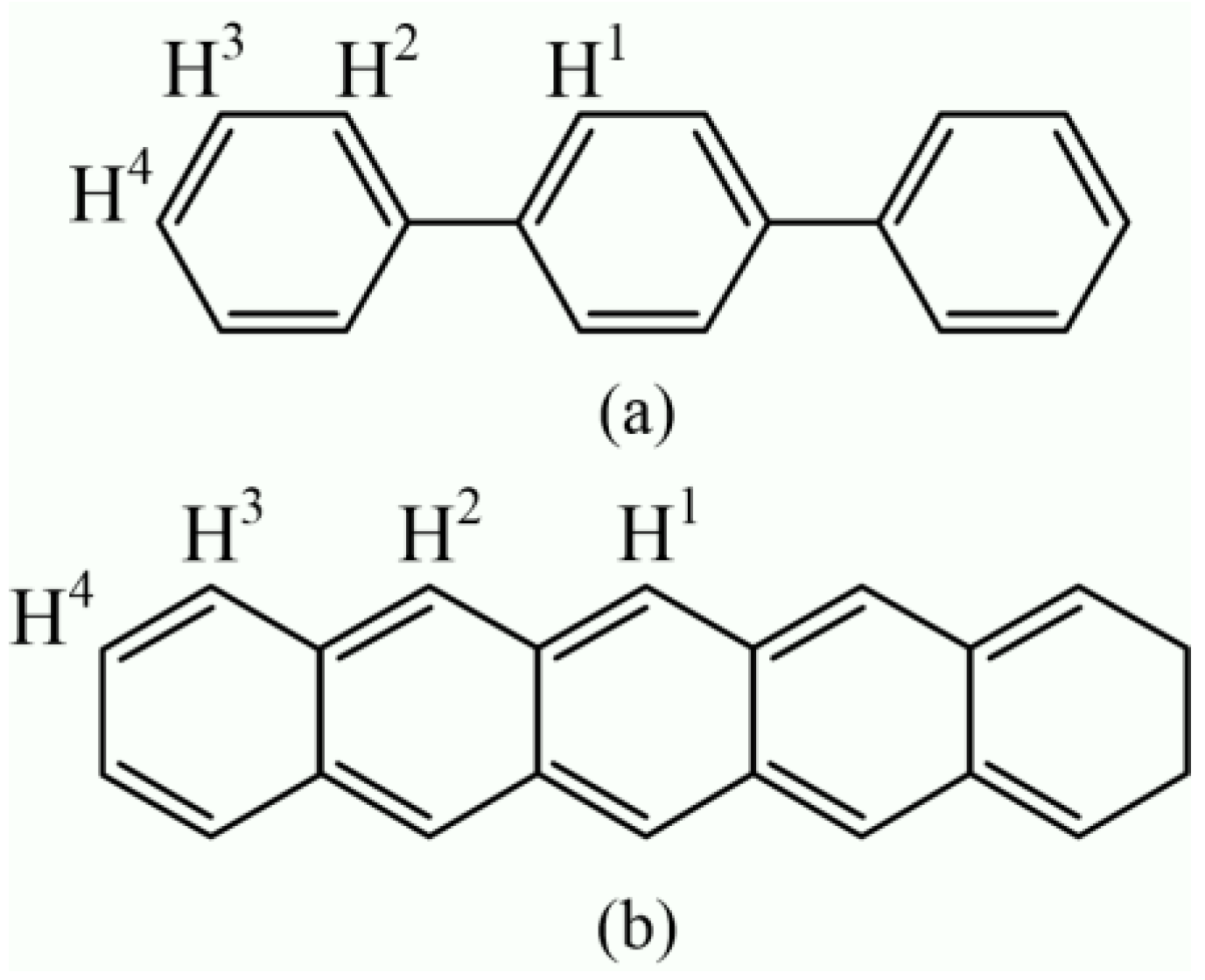
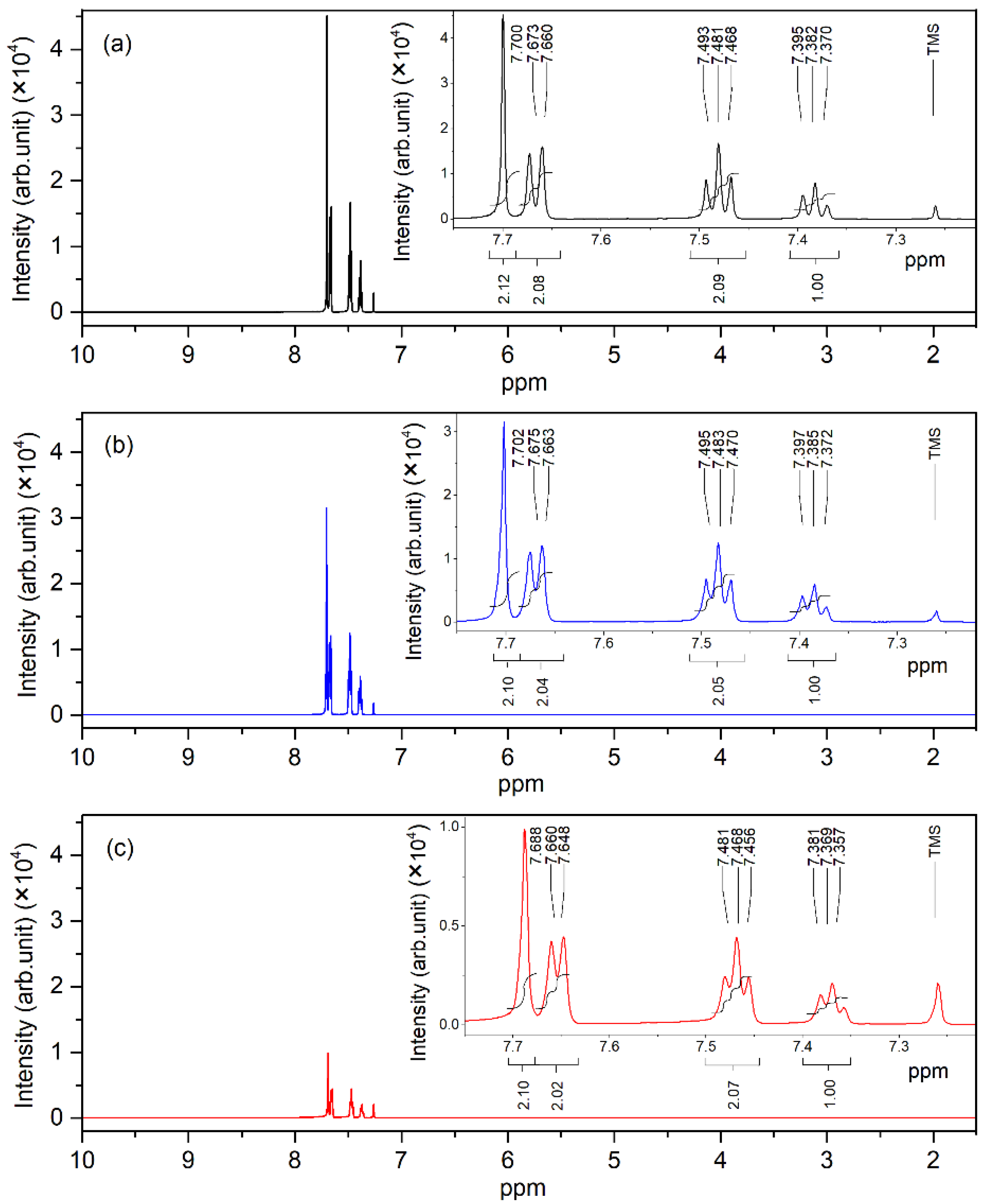
| Parameters | a (Å) | b (Å) | c (Å) | β (°) | V (Å3) |
|---|---|---|---|---|---|
| Single crystal Doped crystal (0.01 wt.%) Doped crystal (0.1 wt.%) CCDC data | 8.111 (2) 8.099 (2) 8.113 (2) 8.099 (1) | 5.610 (1) 5.624 (1) 5.633 (2) 5.607 (1) | 13.605 (1) 13.617 (3) 13.600 (2) 13.604 (1) | 92.42 (3) 91.99 (2) 92.09 (2) 92.033 (1) | 618.42 (9) 619.90 (11) 621.03 (13) 617.32 (6) |
| Crystal Planes | Single Crystal | Doped Crystal (0.01 wt.%) | % Change in Crystallite | Doped Crystal (0.1 wt.%) | % Change in Crystallite | ||||||
|---|---|---|---|---|---|---|---|---|---|---|---|
| 2θ (°) | β (°) | D (nm) | 2θ (°) | β (°) | D (nm) | 2θ (°) | β (°) | D (nm) | |||
| 002 110 111 201 211 | 13.012 19.226 20.435 23.139 28.052 | 0.202 0.273 0.295 0.246 0.269 | 39.144 29.187 27.060 32.598 30.103 | 12.999 19.200 20.409 23.126 28.130 | 0.259 0.295 0.289 0.341 0.325 | 30.529 27.010 27.621 23.516 24.920 | −22.01 −7.46 2.07 −27.86 −17.22 | 13.022 19.172 20.407 23.110 28.129 | 0.333 0.402 0.361 0.329 0.358 | 23.745 19.820 22.112 24.373 22.623 | −39.34 −32.09 −18.29 −25.23 −24.85 |
| Fluorescence Peaks | Sing Crystal | Doped Crystal (0.01 wt.%) | % Change in Intensity | Doped Crystal (0.1 wt.%) | % Change in Intensity | |||
|---|---|---|---|---|---|---|---|---|
| λmax (nm) | If (a.u) | λmax (nm) | If (a.u) | λmax (nm) | If (a.u) | |||
| p-Terphenyl 1 p-Terphenyl 2 | 374 391 | 95.125 93.236 | 375 391 | 35.742 33.888 | −62.43 −63.65 | 375 392 | 27.861 25.561 | −70.71 −72.59 |
| Fluorescence Peaks | Doped Crystal (0.01 wt.%) | Doped Crystal (0.1 wt.%) | % Change in Intensity | ||
|---|---|---|---|---|---|
| λmax (nm) | If (a.u) | λmax (nm) | If (a.u) | ||
| Pentacene 1 Pentacene 2 | 596 646 | 12.994 4.764 | 596 647 | 23.548 11.163 | 81.22 134.32 |
| UV–Vis Absorption Band | Sing Crystal | Doped Crystal (0.01 wt.%) | Doped Crystal (0.1 wt.%) | |||
|---|---|---|---|---|---|---|
| λmax (nm) | lgε | λmax (nm) | lgε | λmax (nm) | lgε | |
| E1 band E2 band B band | 260 330 378 | 0.841 1.233 1.183 | 264 329 383 | 1.166 1.516 1.442 | 264 331 383 | 1.043 1.390 1.322 |
| UV–Vis Absorption Band | Doped Crystal (0.01 wt.%) | Doped Crystal (0.1 wt.%) | ||
|---|---|---|---|---|
| λmax (nm) | lgε | λmax (nm) | lgε | |
| Band 1 Band 2 Band 3 | 503 543 590 | 1.307 1.308 1.317 | 506 544 590 | 1.290 1.337 1.373 |
Disclaimer/Publisher’s Note: The statements, opinions and data contained in all publications are solely those of the individual author(s) and contributor(s) and not of MDPI and/or the editor(s). MDPI and/or the editor(s) disclaim responsibility for any injury to people or property resulting from any ideas, methods, instructions or products referred to in the content. |
© 2022 by the authors. Licensee MDPI, Basel, Switzerland. This article is an open access article distributed under the terms and conditions of the Creative Commons Attribution (CC BY) license (https://creativecommons.org/licenses/by/4.0/).
Share and Cite
Ai, Q.; Chen, P.; Xu, Y.; Zhang, L. Growth of Pentacene-Doped p-Terphenyl Crystals Using SSVBT and Doping Effects in p-Terphenyl Molecular Crystals. Crystals 2023, 13, 2. https://doi.org/10.3390/cryst13010002
Ai Q, Chen P, Xu Y, Zhang L. Growth of Pentacene-Doped p-Terphenyl Crystals Using SSVBT and Doping Effects in p-Terphenyl Molecular Crystals. Crystals. 2023; 13(1):2. https://doi.org/10.3390/cryst13010002
Chicago/Turabian StyleAi, Qing, Peifeng Chen, Yebin Xu, and Lei Zhang. 2023. "Growth of Pentacene-Doped p-Terphenyl Crystals Using SSVBT and Doping Effects in p-Terphenyl Molecular Crystals" Crystals 13, no. 1: 2. https://doi.org/10.3390/cryst13010002
APA StyleAi, Q., Chen, P., Xu, Y., & Zhang, L. (2023). Growth of Pentacene-Doped p-Terphenyl Crystals Using SSVBT and Doping Effects in p-Terphenyl Molecular Crystals. Crystals, 13(1), 2. https://doi.org/10.3390/cryst13010002






